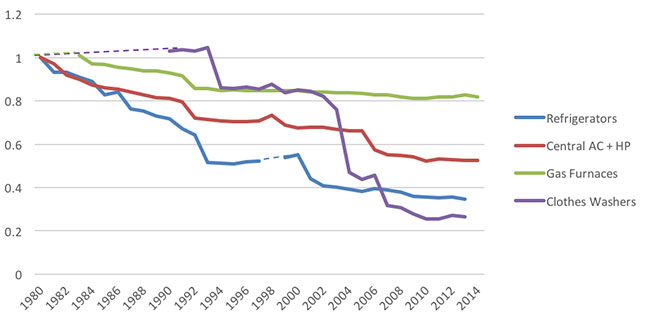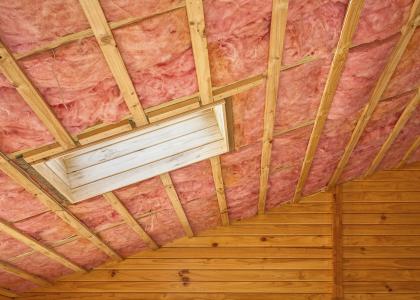Appliance efficiency has increased remarkably over the past several decades. The graph below tracks the energy efficiency of four household appliances over a 35-year period. Three of the products (clothes washers, central air conditioners, and refrigerators), show a 50% or greater reduction in energy use over that period, and the fourth product, gas furnaces, shows a smaller but still significant reduction of 18%.
The decline in energy use parallels the rise of appliance efficiency standards, first at the state level, and then at the federal level. In the 1980s, California and a handful of states set standards for refrigerators, air conditioners, and other home appliances. Federal standards came into play in 1987, when Congress passed a bill that was supported by manufacturers and efficiency advocates. Today, the Department of Energy (DOE) sets minimum energy and water efficiency levels for household and commercial appliances, equipment, and lighting, creating savings for consumers and businesses.
Relative average energy consumption of new appliances sold over the 1980-2014 period
Note: 2014 refrigerator and clothes washer data not yet available. Source: ACEEE analysis of data from Air-Conditioning, Heating, and Refrigeration Institute, Association of Home Appliance Manufacturers, Lawrence Berkeley National Laboratory, and industry sources.
For the residential products in this graph, it is interesting to note that the greater the number of updates to standards, the greater the decline in energy consumption. National clothes washer standards, which were updated 4 times (effective in 1988, 1994, 2004, 2011), saw the steepest decline (75%); refrigerators with 3 updates (effective in 1990, 1993, 2001 but not including the recent update in 2014) saw a 65% decline; and air conditioners with 2 updates (effective in 1992 and 2006), saw a 50% decline. Gas furnaces, with an 18% drop in efficiency, saw just one standard go into effect over this time period in 1992. Fortunately, DOE has an opportunity to set strong new furnace standards as they complete a rulemaking this year.
Washers, refrigerators, air conditioners, and furnaces are just four of the more than 55 products covered by the DOE appliance standards program. Altogether, efficiency standards adopted since 1987 are on track to save consumers and businesses more than $1 trillion through 2020 and to reduce global warming emissions by nearly 4 billion tons, or the equivalent annual emissions of 800 million automobiles. Savings will continue to grow as new standards for products (e.g., portable air conditioners, wine chillers) are adopted and existing standards for products (e.g., air conditioners, dehumidifiers) are updated.
For more on national energy metrics, see Energy Efficiency in the United States: 35 Years and Counting.
Data Points is a blog series focusing on the graphs and other images that tell the energy efficiency story.




